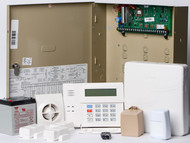The Complete Guide to Purchasing an Intruder Alarm
Apr 16th 2018
Thinking about buying an intruder alarm? This guide will teach you everything you need to know about the different types and the benefits of purchasing.
We're living in an era where concerns over crime and safety have never been more prevalent. So it's not surprising that an increasing amount of households want an intruder alarm.
Properties with a security system are less likely to be burgled by a third! (in comparison to unprotected houses)- so it's no wonder the demand for these alarms is so high!
Should you Opt for a Monitored or Non-Monitored Intruder Alarm?
There are two kinds of intruder alarms: a monitored intruder alarm and a non-monitored one. By monitored, we mean they're linked to a central monitoring response unit.
Monitored Security Alarms
Typically, alarm companies will charge a monthly fee (as well as an installation fee) for their ongoing service. When the company receives an intruder alert, you'll be contacted by the station very quickly.
This is usually done via a telephone call or over the intercom system. You'll then have to verify yourself to the person on the other end.
Often, if you can't verify yourself, the monitoring station will call the police on your behalf- so be sure to know your verification info!
Non-Monitored Security Alarms
A non-monitored intruder alarm isn't linked to a central monitoring station (and therefore usually costs less).
Typically, this kind of system will do one of the following when the intruder alarm goes off:
- Sounds a siren to alert the local area, including anyone who is home, the intruder and close by neighbors.
Wired or Wireless Systems?
Typically, there are two kinds of home security systems: wireless or wired. These two both have sensors placed in strategic locations throughout your home.
These will cause the control panel to send an alarm to the central control unit if triggered while armed. The control panel is linked to a cellular or internet signal and/or a telephone dialer to get help from the company.
A wired security system is made up of low-voltage wires routed discreetly throughout your home. This has in the past been done by an alarm company, however, you can DIY our models as long as you take your time and do your research.
Whereas a wireless security system utilizes small radio transmitters, these send signals to the central control panel if activated. On the plus side, a wireless model is far easier to install.
Equipment Options
You can source alarm systems with any of the following extras:
A Security Keypad
You can opt for an alarm system that's designed for easy arming and disarming. Just type in the code, and you're good to go!
Passive Infrared Detectors
You may know these as motion detectors. This is where sensors are placed around your house to detect any changes in infrared energy levels (high on walls, on top of doors, or windows).
These energy levels work off of changes in heat and motion.
Top tip: You should source sensors that comply with the American National Standards Institute and SIAC standards.
Sirens
You can opt for sirens that make a heck of a ding, in the event of an intrusion. You can choose to install these either inside or outside your home.
This is an excellent way of drawing attention and alerting your neighbors to the fact there might be an intrusion.
A 24-hour Backup System
In the event your phone line gets cut off, or your power's down, your 24-hour backup system will kick in to maintain the alarm (this battery typically lasts for 72 hours).
Remote Controlled System
By this we mean, the ability to disarm the system using a remote controller, like your cell phone. So, you don't have to enter a code into the keypad to shut off the alarm.
Dealing With Pets
If you have indoor pets, you have two options (to ensure they don't trigger your alarm when you've left the house).
One is a sensor that recognizes the difference between a pet that weighs up to 100 pounds and a human. This device has a dual-element sensor. For the alarm to go off, both beams need to be triggered (at the same time).
This is difficult for a pet to do. However, if you have more than one pet prone to play fighting- then they may trigger the alarm!
Alternatively, you could just place the beams high enough above the ground to ensure the movement of any pets isn't detected.
CCTV
In addition to an intruder alarm, you could set up a single video camera and monitor, and a sophisticated closed-circuit television (CCTV). This would allow you to catch any criminals in action!
Did You Enjoy This Blog Post?
If you found this article of interest, then we're confident you'll love the other features published on our blog. Over there we cover everything from home security tips to the benefits of surveillance systems. Enjoy!
Alternatively, if you have any queries about the content of our blog posts or about the products we sell, please feel free to drop us a line.
Just fill in the simple contact form, and one of our friendly staff members will get back to you as soon as they can.


